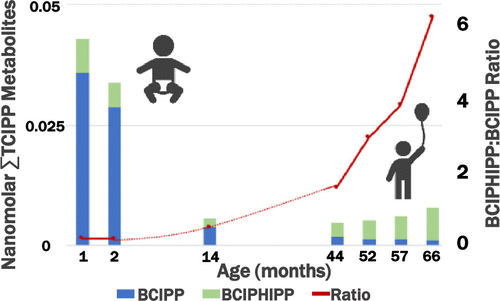当前位置:
X-MOL 学术
›
Environ. Sci. Technol. Lett.
›
论文详情
Our official English website, www.x-mol.net, welcomes your
feedback! (Note: you will need to create a separate account there.)
Reconsidering an Appropriate Urinary Biomarker for Flame Retardant Tris(1-chloro-2-propyl) Phosphate (TCIPP) Exposure in Children
Environmental Science & Technology Letters ( IF 8.9 ) Pub Date : 2020-11-18 , DOI: 10.1021/acs.estlett.0c00794 Stephanie C. Hammel 1, 2 , Heather M. Stapleton 1, 2 , Brian Eichner 3 , Kate Hoffman 1, 2
Environmental Science & Technology Letters ( IF 8.9 ) Pub Date : 2020-11-18 , DOI: 10.1021/acs.estlett.0c00794 Stephanie C. Hammel 1, 2 , Heather M. Stapleton 1, 2 , Brian Eichner 3 , Kate Hoffman 1, 2
Affiliation

|
Tris(1-chloro-2-propyl) phosphate (TCIPP) is frequently applied to consumer products as a flame retardant and is commonly detected in indoor environments. Urinary bis(1-chloro-2-propyl) phosphate (BCIPP) is typically measured as TCIPP’s primary biomarker but has been inconsistently detected. Bis(2-chloro-isopropyl) hydroxy-isopropyl phosphate (BCIPHIPP) was suggested as an improved biomarker due to its common urinary detection. To evaluate biomarker utility, we compiled individual data from children ages 1 month to 6 years (n = 292) from two cohort studies (2014–2018). Concentrations of BCIPP, BCIPHIPP, their molar sum, and their ratio were examined for association with age and other characteristics. Both biomarkers were detected frequently (>80%); however, metabolite levels and dominant metabolite varied with age. For each month increase in age, the molar sum of metabolites decreased by 4% (10β = 0.96; 95% CI = 0.95–0.98), which was driven by decreasing BCIPP. The BCIPHIPP:BCIPP ratio also increased by 0.10 per month of age (95% CI = 0.08–0.13). Children with a college graduate parent had lower ratios (p = 0.0003) despite no difference in molar sum of metabolites. Metabolism differences and changing exposure pathways during early life may contribute to observed patterns. Cumulatively, results suggest biomonitoring efforts should include BCIPP, BCIPHIPP, and other possible metabolites, since a single biomarker could underestimate total TCIPP exposure.
中文翻译:

重新考虑儿童的阻燃性三(1-氯-2-丙基)磷酸酯(TCIPP)暴露的尿液生物标志物
磷酸三(1-氯-2-丙基)磷酸酯(TCIPP)通常作为阻燃剂应用于消费品,通常在室内环境中检测到。尿双(1-氯-2-丙基)磷酸酯(BCIPP)通常被测量为TCIPP的主要生物标志物,但检测到不一致。由于其常见的尿液检测,建议使用双(2-氯-异丙基)羟基-异丙基磷酸酯(BCIPHIPP)作为改进的生物标记。为了评估生物标志物的效用,我们汇总了1个月至6岁(n= 292)来自两项同期队列研究(2014-2018年)。检查BCIPP,BCIPHIPP的浓度,其摩尔总和及其比例与年龄和其他特征的关系。两种生物标志物均被频繁检测(> 80%);然而,代谢物水平和主要代谢物随年龄而变化。对于年龄每月增加,代谢物的摩尔总数减少了4%(10 β = 0.96; 95%CI = 0.95-0.98),这是通过减少BCIPP驱动。BCIPHIPP:BCIPP比率也每个月增加0.10(95%CI = 0.08-0.13)。父母拥有大学毕业的孩子的比率较低(p= 0.0003),尽管代谢物的摩尔总和没有差异。生命早期的代谢差异和不断变化的暴露途径可能会导致观察到的模式。累积的结果表明,生物监测工作应包括BCIPP,BCIPHIPP和其他可能的代谢产物,因为单个生物标志物可能会低估TCIPP的总暴露量。
更新日期:2020-11-18
中文翻译:

重新考虑儿童的阻燃性三(1-氯-2-丙基)磷酸酯(TCIPP)暴露的尿液生物标志物
磷酸三(1-氯-2-丙基)磷酸酯(TCIPP)通常作为阻燃剂应用于消费品,通常在室内环境中检测到。尿双(1-氯-2-丙基)磷酸酯(BCIPP)通常被测量为TCIPP的主要生物标志物,但检测到不一致。由于其常见的尿液检测,建议使用双(2-氯-异丙基)羟基-异丙基磷酸酯(BCIPHIPP)作为改进的生物标记。为了评估生物标志物的效用,我们汇总了1个月至6岁(n= 292)来自两项同期队列研究(2014-2018年)。检查BCIPP,BCIPHIPP的浓度,其摩尔总和及其比例与年龄和其他特征的关系。两种生物标志物均被频繁检测(> 80%);然而,代谢物水平和主要代谢物随年龄而变化。对于年龄每月增加,代谢物的摩尔总数减少了4%(10 β = 0.96; 95%CI = 0.95-0.98),这是通过减少BCIPP驱动。BCIPHIPP:BCIPP比率也每个月增加0.10(95%CI = 0.08-0.13)。父母拥有大学毕业的孩子的比率较低(p= 0.0003),尽管代谢物的摩尔总和没有差异。生命早期的代谢差异和不断变化的暴露途径可能会导致观察到的模式。累积的结果表明,生物监测工作应包括BCIPP,BCIPHIPP和其他可能的代谢产物,因为单个生物标志物可能会低估TCIPP的总暴露量。











































 京公网安备 11010802027423号
京公网安备 11010802027423号